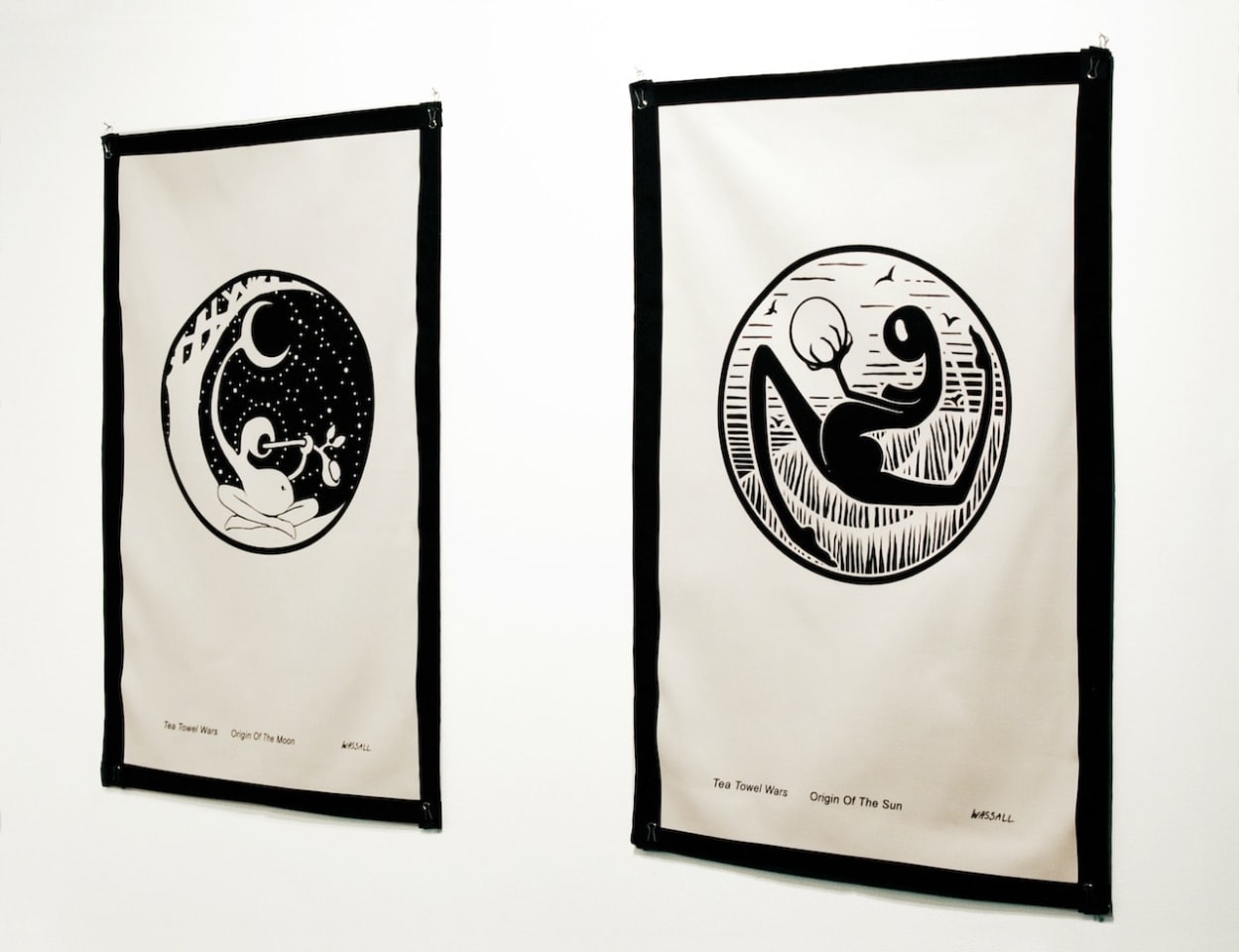Nicole Wassall
Tea Towel Wars - Origin of the Moon, 2023
100% natural Panama cotton 309gsm, with 4 hand hemmed sides and a black hanging loop.
Printed using reactive inks so they wash well, keep their colour longer and are kinder on the environment.
Printed using reactive inks so they wash well, keep their colour longer and are kinder on the environment.
71 x 46 cm
28 x 18 1/8 in
28 x 18 1/8 in
Open Edition
Copyright The Artist
Further images
100% natural Panama cotton 309gsm, with 4 hand hemmed sides and a black hanging loop decorated with the Dreamtime tale of Ngalindi. Decorated tea towels became status symbols in Victorian...
100% natural Panama cotton 309gsm, with 4 hand hemmed sides and a black hanging loop decorated with the Dreamtime tale of Ngalindi.
Decorated tea towels became status symbols in Victorian England, as textiles became more available, and genteel women hand embroidered them to show off their creativity and good taste. Whilst this tradition has largely died out, the humble tea towel has remained popular for both its design and versatility.
Now the responsibility for ‘washing up’ has become a symbolic battle ground for domesticated equality. The title of this piece, Tea Towel Wars, both trivialises domestic disharmony caused by sexism and seemingly contradicts itself by putting a focus on the ridiculousness of the same lack of domestic equality.
The two tea towels borrow from Australian Aboriginal Dreamtime stories. Unlike many European narratives, that put the man as the strong sun and the moon as the weak and sickly woman (as expressed in the early feminist poem ‘In Dispraise of the Moon’ by Mary Elizabeth Coleridge published in 1893), the Aboriginal tradition puts the woman as the tireless sun and the moon as the lazy man. A poignant destination given the Australian Aboriginal culture is the oldest civilisation on earth, dating back some 75000 years, and the sun is placed in the centre of the Australian Aboriginal flag.
Tea Towel Wars - Origin of the Moon
Ngalindi was lazy and greedy, he ate and did nothing until he was round and fat. This made his wives angry and they threw axes to slice bits of him off. He tried to escape, by climbing a tree, but was fatally wounded. As he died he cursed all animals and people so they would no longer be immortal, but he would live forever. Each month he is reborn as the waxing moon, he eats until he is round and fat and his wives throw axes so he becomes the waning moon. With the final blow he dies and remains dead for three days before he’s reborn into the new cycle.
These stories are from the Yolngu people of Northern Australia. Nicole Wassall, the artist, acknowledges the First Nations peoples as the original storytellers. She pays her respect to the Aboriginal cultures; and to Elders past and present.
Decorated tea towels became status symbols in Victorian England, as textiles became more available, and genteel women hand embroidered them to show off their creativity and good taste. Whilst this tradition has largely died out, the humble tea towel has remained popular for both its design and versatility.
Now the responsibility for ‘washing up’ has become a symbolic battle ground for domesticated equality. The title of this piece, Tea Towel Wars, both trivialises domestic disharmony caused by sexism and seemingly contradicts itself by putting a focus on the ridiculousness of the same lack of domestic equality.
The two tea towels borrow from Australian Aboriginal Dreamtime stories. Unlike many European narratives, that put the man as the strong sun and the moon as the weak and sickly woman (as expressed in the early feminist poem ‘In Dispraise of the Moon’ by Mary Elizabeth Coleridge published in 1893), the Aboriginal tradition puts the woman as the tireless sun and the moon as the lazy man. A poignant destination given the Australian Aboriginal culture is the oldest civilisation on earth, dating back some 75000 years, and the sun is placed in the centre of the Australian Aboriginal flag.
Tea Towel Wars - Origin of the Moon
Ngalindi was lazy and greedy, he ate and did nothing until he was round and fat. This made his wives angry and they threw axes to slice bits of him off. He tried to escape, by climbing a tree, but was fatally wounded. As he died he cursed all animals and people so they would no longer be immortal, but he would live forever. Each month he is reborn as the waxing moon, he eats until he is round and fat and his wives throw axes so he becomes the waning moon. With the final blow he dies and remains dead for three days before he’s reborn into the new cycle.
These stories are from the Yolngu people of Northern Australia. Nicole Wassall, the artist, acknowledges the First Nations peoples as the original storytellers. She pays her respect to the Aboriginal cultures; and to Elders past and present.





